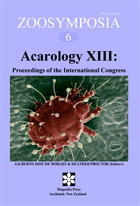Abstract
Carnation holds a prominent place and a good market among the various cut flowers in Himachal Pradesh, India, but it can be severely attacked by the two spotted spider mite, Tetranychus urticae Koch. Indiscriminate use of pesticides has led to development of resistance in this species, affected human health and caused environmental pollution. The determination of safer and more cost effective and eco-friendly alternative approaches for the management of this pest is desirable. Different combinations of three weekly applications of a predator [the phytoseiid Neoseiulus longispinosus (Evans)], a fungus [a commercial formulation of Lecanicillium (= Verticillium) lecanii (Zimmerman)], a plant extract (a commercial neem formulation), a conventional chemical mitecide (Profenofos) or water (control) were tested in 2008 and 2009. In both years, the best results were obtained by three subsequent weekly releases of N. longispinosus and three subsequent applications of Profenofos. These results show the potential of this predatory mite as a control agent of two spotted spider mite on carnation under greenhouse conditions in Himachal Pradesh.

